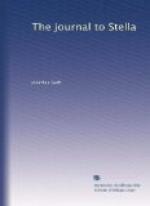Swift’s visit to London in 1707-9 had for its object the obtaining for the Irish Church of the surrender by the Crown of the First-Fruits and Twentieths, which brought in about 2500 pounds a year. Nothing came of Swift’s interviews with the Whig statesmen, and after many disappointments he returned to Laracor (June 1709), and conversed with none but Stella and her card-playing friends, and Addison, now secretary to Lord Wharton.[4] Next year came the fall of the Whigs, and a request to Swift from the Irish bishops that he would renew the application for the First-Fruits, in the hope that there would be greater success with the Tories. Swift reached London in September 1710, and began the series of letters, giving details of the events of each day, which now form the Journal to Stella. “I will write something every day to MD,” he says, “and make it a sort of journal; and when it is full I will send it, whether MD writes or no; and so that will be pretty; and I shall always be in conversation with MD, and MD with Presto.” It is interesting to note that by way of caution these letters were usually addressed to Mrs. Dingley, and not to Stella.
The story of Swift’s growing intimacy with the Tory leaders, of the success of his mission, of the increasing coolness towards older acquaintances, and of his services to the Government, can best be read in the Journal itself. In the meantime the intimacy with the Vanhomrighs grew rapidly. They were near neighbours of Swift’s, and in a few weeks after his arrival in town we find frequent allusions to the dinners at their house (where he kept his best gown and periwig), sometimes with the explanation that he went there “out of mere listlessness,” or because it was wet, or because another engagement had broken down. Only thrice does he mention the “eldest daughter”: once on her birthday; once on the occasion of a trick played him, when he received a message that she was suddenly very ill ("I rattled off the daughter"); and once to state that she was come of age, and was going to Ireland to look after her fortune. There is evidence that “Miss Essy,” or Vanessa, to give her the name by which she will always be known, was in correspondence with Swift in July 1710—while he was still in Ireland—and in the spring of 1711;[5] and early in 1711 Stella seems to have expressed surprise at Swift’s intimacy with




